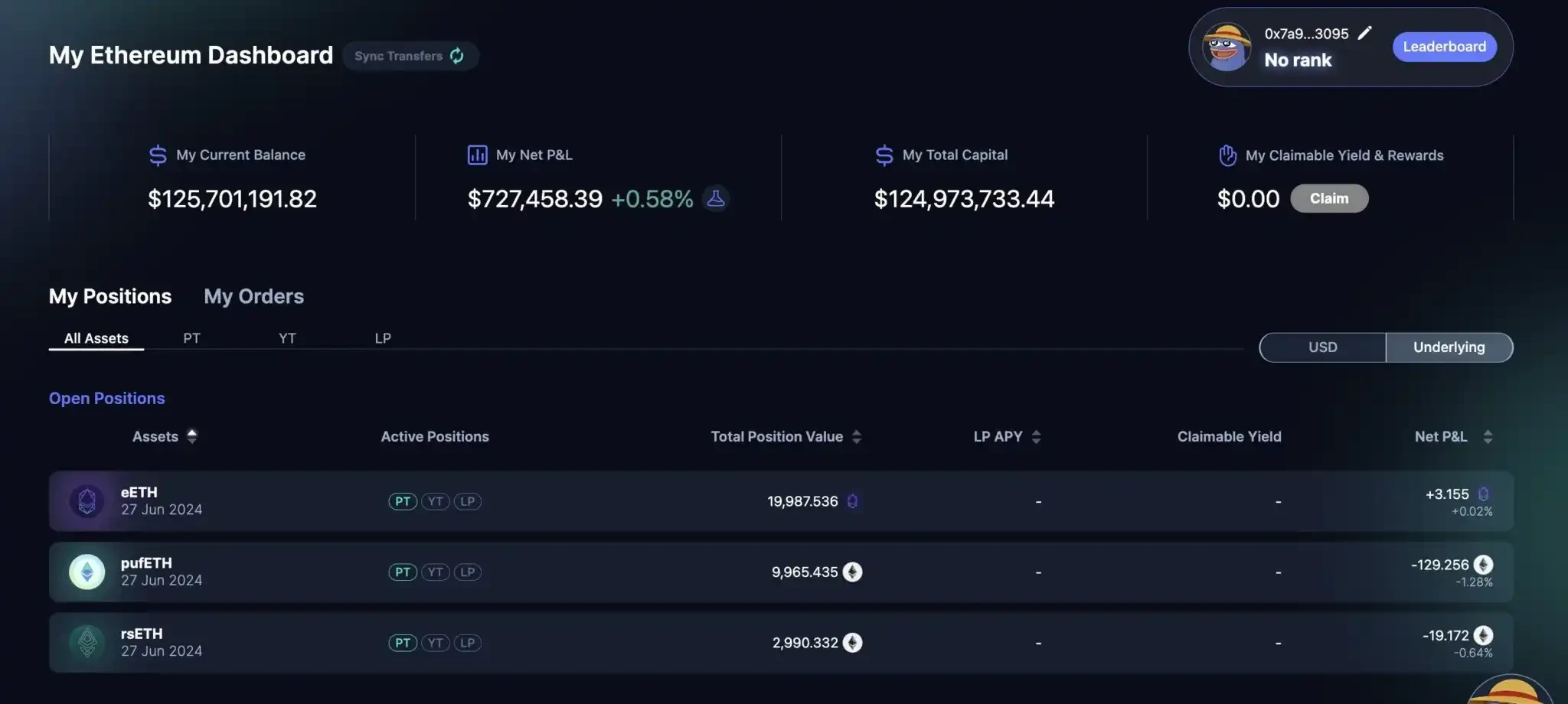原作者: DaFi Weaver、BlockTempo
4日、TRONの創設者であるジャスティン・サンはPendle PTトークンを大量に購入し、年間収益率が約20%の低リスク裁定取引を実現し、コミュニティの注目を集めました。この記事では、この一連の取引の利益がどこから来るのかを説明し、関連するリスクを探り、読者の参考となるリスク回避戦略を提供します。
孫格裁定取引法
まず、オンチェーンアドレスを監視するオンチェーンアナリストのYu Jin氏とAunt Ai氏によると、Brother Sun氏の過去2日間の活動は以下のとおりです(次の図は、Brother Sun氏のPendleにおけるポジションを示しています)。
6月27日に期限が切れたイーサリアム再ステーキングプロジェクトには合計3,3000 ETHが投資されました。
-
Ether.fi: 20,000 ETH を 20,208.93 PT-weETH で購入。
-
Puffer: 10,000 ETH を 10,114.11 PT-pufETH で購入。
-
ケルプ: 3,000 ETH 3,025.91 PT-rsETH を購入
孫格のペンドルでの地位|出典:艾叔母
Ether.fiを例にとると、Sunが満期まで保有すれば、20,208.93 ETHに相当するweETHを償還できることになります(注:これは20,208.93 weETHに相当しません。weETHとETHの交換レートは1:1ではありません。以下を参照)。weETHをいくらのETHに交換できるかは市場の状況によって異なります。ここでは簡単な計算として、weETHとETHの交換レートが1:1であると仮定すると、Sunが満期まで保有すれば、22日間で1%の利回りを得ることができ、年間17.33%になります。
同様に、Puffers の年間投資収益率は 18.93%、Kelps は 14.33% です。合計年間投資収益率は 17.54% にもなります。
Pendle Chinese Community Ambassador の ViNc 氏は、Pendles PT はチェーン上の短期債務のようなもので、流動性が高く、償還時に現金価値に近い (ETH で見ると)、期間が短く、リスクと報酬の比率が良いという特徴があると説明しました。では、PT の収入はどこから来るのでしょうか。これには、Pendle プロトコルの基本的な動作を理解する必要があります。
weETHとETHの交換レートは1:1ではない|出典:1inch PT収入源
Pendle は、利回りのあるトークンを標準化された利回りトークン (weETH → SY-weETH などの SY、このパッケージ バージョンは Pendle AMM と互換性があります) にパッケージ化し、SY を PT (プリンシパル トークン) と YT (利回りトークン) の 2 つの部分に分割する、許可のない利回り取引プロトコルです。
PTは満期日までの利子付きトークンの元本部分を表し、この期間中に収益を得る権利はYTで表され、他の購入者に販売されます。YTの金銭的価値が分離されているため、元本部分(つまりPT)はより低い価格で販売できます。
Pendle に参加するには、主に 3 つの方法があります。
-
PT を購入: PT は、満期後に保有者が原資産を償還することを可能にし、いつでも売却できます。たとえば、期間の初めに 0.9 ETH で購入した 1 PT-weETH は、満期日後に 1 ETH に相当する weETH に償還できます。0.9 ETH → 1.0 ETH 間の 11% 上昇は、ペンドルの固定利回り戦略です。そして、これは孫策が採用した戦略です。
-
YT を購入: 保有者は有効期限前に原資産によって生成されたすべての収入とエアドロップ ポイントを取得でき、いつでも売却することもできます。たとえば、1 YT-weETH を保有すると、有効期限まで 1 weETH によって生成されたすべての収入とポイントを受け取る権利を持つことになります。
-
流動性プロバイダー (LP) として: LP の収入には、PT 収入 + SY 収入 + ($PENDLE 排出 + プール取引手数料) が含まれます。
価格リスクを回避する方法:借入と空売り
このような印象的な収益率を考えると、Pendle を使用するリスクは主にスマート コントラクト リスク、運用における人的リスク、価格リスク (U 基準で) です。通貨基準で見ると、PT を購入する戦略は確実に勝ちます。
価格リスク、つまり価格下落による損失をさらに回避するには、取引所でショート契約を開くという対応策を試みることができますが、これには清算リスクと資金調達率を考慮する必要があります。すべてがうまくいけば、固定収入を得ることができます。例:
1ETHを$3,800で購入した場合、6月27日に期限が切れるEther.fiマーケットで1.01PT eETHに交換できるため、期限切れ後に約0.01ETHの純利益を得ることができるということになります。
しかし、ETH価格の下落を避けるために、取引所で1ETH相当のショート注文が開かれました。満期後、ショート注文と1ETHは閉じられ、同時に売却されました。このようにして、US$3,800のコストを回収することに加えて、0.01ETHの安定した収入も得られました。
もう一つの方法は、アルビンの資本保全戦略(この戦略は最近ペンドルの役員によって提案されました)を引用し、PTを購入するためにお金を借りることです。同じ例をとると、方法は次のとおりです。
1. CEX/DEXで1ETHを借りる
2.借りたETHを使って1.01 PT eETHを購入する
3. 満期時に1.01 ETH相当のeETHを償還し、1 ETHを返済する
4. 残りの ETH は安定した収入であり、約 0.01 ETH と見積もられています。これは、上で説明したように、eETH と ETH の市場状況によって異なります。
この戦略では、安定した収入が借入コストを上回ることができるかどうかを考慮する必要があります。そうでない場合は、依然として損失が発生する可能性があります。
この記事はインターネットから引用したものです: Sun Ges アービトラージ手法の詳細な説明: 33,000 ETH で PT トークンを購入し、約 20% の収益率を享受
関連: Starknet が Bitcoin Layer2 分野に参入すると発表したことについてどう思いますか?
原著者:Haotian 要約:1)Starknetがビットコインを拡張するための前提条件は、OP_CAT提案が最初に可決されることですが、これは不確実です。2)StarknetがBTCレイヤー2に参入することで、BTCエコシステムが東は明るく、西は明るくないという厄介な状況を打破できる可能性があります。3)レイヤー2がレイヤー1に傾く傾向が強まっています。高性能はStarknetの差別化の利点になりますか?次に、私の意見をお話しします。1)OP_CATは、複数のUTXOロック解除スクリプトバイト文字列の結合リンク処理を実現できるため、BTCメインネットワークのプログラミング性が大幅に向上します。OP_CATを使用すると、スクリプトフラグメントを組み合わせることができ、STARK証明は非常にシンプルで効率的な計算検証方法です。OP_CATの基礎により、Starknetは当然…










